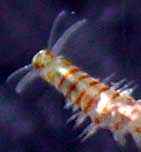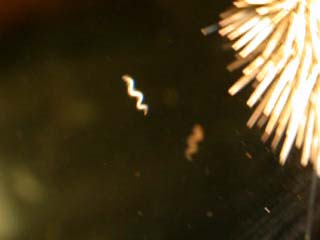Biology Photo of the Month
- April 2002
Swimming,
swarming, spawning polychaete worms
Photos and
text by Bill Capman

Head of tiny polychaete worm
- move cursor over
photo for view of the same sort of worm swimming
Late in the evening around
10:00 PM on March 9, 2002, excitement had broken out in the sea urchin
tank in Augsburg's general biology lab. In the darkness of the night,
a multitude of tiny creatures were swarming in the tank. At first it
was difficult to tell what these small swimming creatures were. However,
an overhead projector was nearby, and strong side illumination of the
tank using the projector gave a clear view, revealing their identity.
The small creatures were in fact small worms a centimeter or so in length,
swimming about and presumably spawning.
These worms normally stay
hidden in the sand and rocks, though they are occasionally seen crawling
about on the walls of the aquarium, especially at night. This particular
evening though the worms were all over the place, zipping about, and
attracted to the light like insects to a porch light on a summer night.
The next several evenings not a single swimming worm could be found,
so it appears the night of March 9 was indeed somewhat special.
Click
here or on photo below for a short Quicktime movie that shows several
of these worms swimming (1 MB file...may take a few minutes to download)

Click photo
to view movie
(Note: the
white object on the top right is a sea urchin)
Though members of the same
phylum (Annelida, the segmented worms) as the earthworms in your backyard,
these tiny marine worms are quite unlike anything you are likely to
find in your yard. While earthworms and most of the other worms on land
and in freshwater are oligochaete worms, most species of marine worms
(including the little swarmers in our aquarium) are polychaete worms
(Note: the primarily freshwater leeches belong to yet a third common
class of annelid worms). "Oligo" means few, and oligochaete
means "few setae" (few bristles). "Poly" means many,
so polychaete means "many setae". Indeed, as can be seen in
the photo below, the little swarming worms are equipped with abundant
bristles, much more so than the earthworms in your garden. Many polychaete
worms also have much more distinct heads (often with well-developed
jaws) than oligochaete worms, and many have conspicuous leg-like appendages
called parapodia (also visible below...the setae are attached to the
parapodia).

Click
to view photo at full size
Closeup of one of the
swimming worms. We don't know the identity of this particular species,
though it appears to have arrived in our aquaria along with a shipment
of sea urchins from Florida. Several similar worms were present
among the detritus in the urchin shipping water.
Most marine invertebrates
(animals without backbones) and marine fish have planktonic larval stages
that typically look very little like the adults. These planktonic larvae
drift in the water currents for days, weeks, or months (depending on
the species), feeding on planktonic algae or other planktonic organisms
until they eventually undergo a metamorphosis to the adult body form.
They then settle out of the plankton into suitable habitats (the few
lucky survivors that did not get eaten or carried to unsuitable locations
do anyway), where they take up a lifestyle more similar to the adults.
To give their offspring a good start in life and help them to be better
swept away in the water currents, many marine invertebrates and fish
either climb to the highest spot in the area or swim to the water surface
(as is the case with these small swimming worms in our aquarium) before
releasing eggs or larvae.
Quite a few species of polychaetes
engage in this sort of spawning behavior, and at certain times of the
year swarms of spawning polychaete worms can be quite conspicuous at
night in coastal areas. As is the case with many marine creatures, spawning
is often coordinated with lunar cycles. In the Florida Keys and the
Caribbean some polychaete worms are even bioluminescent! These worms,
known as bioluminescent threadworms, can be quite conspicuous in nearshore
waters in the Spring. Just after sunset, females of these worms swim
to the surface where they flash a bright green light that attracts the
males.
As might be imagined, swimming
about for the purpose of spawning subjects polychaete worms to increased
danger from predators, but some species minimize this risk by producing
a tail region that breaks loose and swims, carrying the gametes to the
surface. These dismembered swimming worm tails are called epitokes,
and they allow the worm itself to remain safely hidden while its sperm
or eggs are carried up into the water column for fertilization and dispersal
on the water currents to new sites .
A diagram of an epitoke of
a polychaete worm is shown below:

Polychaete worms of many
shapes, sizes, and lifestyles are extremely abundant and diverse in
marine (saltwater) habitats. Some are free-living like the ones discussed
here, while others such as the feather duster worms (which live in tubes
that they construct) live much more sedentary lifestyles. Many sorts
can be found in reef aquaria such as
Augsburg's coral reef aquaria, and many more types can be
found in the wild.
A good introduction to the
diversity of polychaete worm forms and lifestyles can be found in the
following Aquarium Frontiers online magazine article by Ron Shimek:
http://www.animalnetwork.com/fish2/aqfm/1998/june/wb/default.asp
See also:
Archive
of past photos and stories
|

